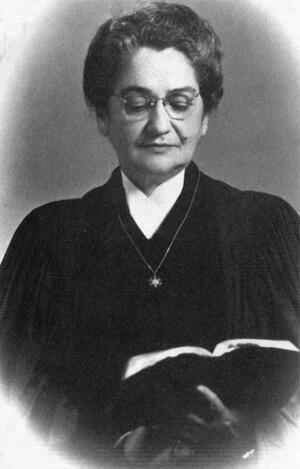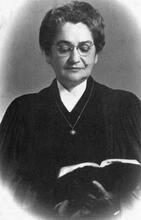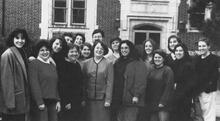Paula Ackerman
Paula Ackerman, reading from a religious text.
When Paula Ackerman's husband, William Ackerman, died in 1950, his congregation, the Reform Temple Beth Israel of Meridian, Mississippi, requested that she succeed him. Thus, Paula Ackerman became the first female spiritual leader of a mainstream Jewish congregation in the United States.
Institution:The Jacob Rader Marcus Center of the American Jewish Archives, Cincinnati, OH.
Paula Ackerman was a passionate student from a young age and began her career as a high school teacher. When she and her husband, a rabbi, moved to a new congregation in Meridian, Mississippi, Ackerman taught in the religious school and led services when her husband was ill. After his death in 1950, the congregation asked her to take over as leader of the synagogue, requesting special permission from the Reform movement and insisting they would have no other. For the next three years, Ackerman was the first woman to serve as religious leader of a mainstream American congregation, helping to pave the way for the ordination of women rabbis twenty years later.
At the turn of the twentieth century, a young girl from Pensacola, Florida, named Paula Herskovitz dreamed of one day becoming a medical doctor. Believing that the medical profession was unsuitable for women, her father insisted that she abandon her dream. Yet decades later, she embarked upon a career he no doubt would have found equally unsuitable: she became a spiritual leader.
Early Life and Career
Paula (Herskovitz) Ackerman was born on December 7, 1893, to Joseph and Dora Herskovitz. Ackerman later described her mother as a pious woman who imbued her home with Jewish teachings and values. Her father, raised in a traditionally religious home in Romania, initially intended to provide a Hebrew education for his sons only. Having long since abandoned the Orthodoxy of his youth, however, and recognizing his daughter’s great desire to study, he hired a local Orthodox rabbi to tutor his three children to supplement their weekly religious education at Temple Beth-El, the Reform congregation of which they were members.
Valedictorian of her high school class in 1911, Ackerman was offered a scholarship to Sophie Newcomb College in New Orleans, but because of her father’s refusal to let her pursue a medical career, she declined it. Financial difficulties later required that she help support her family, so she became a private music instructor and high school Latin and math teacher. She also taught at Beth-El, led the congregational choir, and began a seven-year courtship with its newly hired rabbi, Dr. William Ackerman. Married in 1919, they soon left Pensacola for a better paying rabbinic position in Natchez, Mississippi. In 1924, they moved with their fifteen-month-old son, Billy, to Meridian, Mississippi, which for almost fifty years remained Paula Ackerman’s home.
During her husband’s tenure as rabbi of Temple Beth Israel, a Reform congregation in Meridian with a membership of approximately 150 families, Paula Ackerman taught preconfirmation classes and led religious services when her husband was ill or out of town. Still, she was unprepared for the congregation’s request, less than a month after William Ackerman’s death in November 1950, that she succeed him.
Congregational Leader
Ackerman’s initial response was that they should hire a formally trained rabbi with greater Judaic knowledge. Having received informal permission from Maurice Eisendrath, president of the Union of American Hebrew Congregations (the Reform Movement), the congregation persisted, and, by January, she accepted, viewing the invitation as both a divine call to service and an opportunity “to plant a seed for enlarged activity for the Jewish woman.”
Soon after, Eisendrath withdrew his approval, maintaining that in discussing the matter with other rabbis he had concluded that congregational leaders unqualified to discharge full rabbinical duties would create more problems than they would solve. His letter, apparently, was ignored, for, as the congregation’s president had already informed him, in the eyes of “practically all of the members of our congregation she is qualified, and we want her.”
From January 1951 through the fall of 1953, Paula Ackerman served as Temple Beth Israel’s spiritual leader, conducting services, preaching, teaching, and performing marriages, funerals, and conversions. In so doing, she achieved the distinction of becoming the first woman to assume religious leadership of a mainstream American Jewish congregation. Attracting international attention from the press, she was erroneously labeled “America’s first Lady Rabbi.”
Later Life
After retirement, Ackerman remained active on city, state, and national religious and cultural boards and traveled throughout the United States, lecturing on religious themes. In 1962, she agreed to become spiritual leader of Temple Beth-El in her hometown of Pensacola until a new rabbi could be found. Six months later, she returned full-time to Meridian, subsequently moving to Pensacola (1970), Atlanta (1981), and Thomaston, Georgia (1985).
In 1986, at a special ceremony held at The Temple in Atlanta, the Union of American Hebrew Congregations formally recognized her pioneering contribution to Jewish communal life. Paula Ackerman died in Thomaston on January 12, 1989.
Ackerman, Paula. Papers. American Jewish Archives, Cincinnati, Ohio, and Sermons (1915–1953). Private possession of Dr. William Ackerman.
Olitzky, Kerry, Lance Sussman, and Malcolm Stern, eds. Reform Judaism in America: A Biographical Dictionary and Sourcebook. 1993.
Umansky, Ellen M. “Reform’s Lost Woman Rabbi: An Interview with Paula Ackerman.” Genesis 2, no. 17 (June/July 1986) 3: 18–20.
Umansky, Ellen M., and Dianne Ashton, eds. Four Centuries of Jewish Women’s Spirituality: A Sourcebook (1992).





